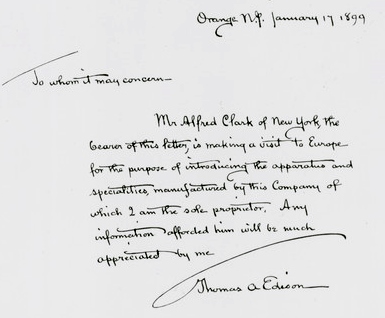Alfred Clark (director) facts for kids
Quick facts for kids
Alfred Clark
|
|
|---|---|
 |
|
| Born | 19 December 1873 New York City, United States
|
| Died | 16 June 1950 (aged 76) Fulmer, England
|
| Occupation | cinematographer, gramophone inventor and executive |
Alfred Clark (1873–1950) was a true pioneer in the worlds of music recording and movies. He worked for Thomas Edison at his very first film studio, called the Black Maria. There, Alfred Clark helped create the first moving pictures with new ideas. These included using a story (plot), making scenes flow together (continuity), using trained actors, and even adding special effects!
Later, in 1896, he joined the Gramophone Company. He then moved to Europe and became a very important leader for famous music companies like HMV and EMI. Alfred Clark also became a British citizen in 1928. He was a key member of the Oriental Ceramic Society in London. He built an amazing collection of rare Chinese pottery, including pieces made for ancient emperors of the Tang and Song dynasty.
In 1921, he married Ivy Sanders. She lived longer than him and passed away in 1973.
Contents
Alfred Clark's Early Life
Alfred Clark was born in New York on December 19, 1876. He went to school at the Franklin School in Washington and the City College of New York. He was very interested in electricity from a young age. He left college at 16 to work for the North American Phonograph Company.
When that company closed in 1894, Clark joined Thomas Edison. He helped make some of the earliest short movies using Edison's Kinetoscope technology. This happened at the Black Maria studio. Before Clark, Edison's films were mostly about boxing or stage shows. But Alfred Clark introduced the idea of films with a story and scenes that connected. One famous short film was Execution of Mary Stuart. It even had one of the very first special effects to show a beheading!
Pioneering the Gramophone
Alfred Clark was most interested in recording sound. After a year of making movies, he worked for Edison's phonograph company. At the same time, he took evening classes and worked with Emile Berliner and Eldridge Johnson. They were developing the gramophone. This was a much better technology than the phonograph. It allowed many copies of recordings to be made from one metal master.
Clark invented some important parts for the gramophone. These included a special device called a governor to control the playback speed. He also improved the part that produced the sound, called the sound box.
In 1899, Clark went to France to represent both Edison and Berliner. The gramophone technology became very popular. Clark started the Compagnie de Gramophone Française. This company recorded famous artists like Claude Debussy and Edvard Grieg. In 1907, he helped create the Musée de la Voix (Museum of the Voice). For this, he received a special award called the Legion of Honour.
In 1908, he moved to Britain. There, he became the managing director of the Gramophone company. He reorganized it and built a factory in Hayes. The First World War caused problems for the business. They had to focus on making things for the war.
After the war, Clark worked with Eldridge Johnson's Victor Talking Machine Company. He also bought the Marconiphone business. This was important because it brought new radio and electronics technology. These were becoming very popular for home entertainment. In 1931, his company joined with the Columbia Graphophone Company to form EMI. This new company worked hard to save money and stay strong during the Great Depression. They also kept developing new technology, including television. The BBC even started broadcasting TV using an EMI system in 1936. The Second World War again stopped consumer developments. The company switched to making war items like radar. Alfred Clark was the chairman and sometimes managing director during this time. He retired in 1946.
Collecting Chinese Ceramics
Alfred Clark built one of the most important collections of Chinese pottery in the Western world. In 1936, he gave a special bowl to the British Museum. It was a Ru ware brush-washer bowl. This bowl was even shown at an exhibition in the Palace Museum in Beijing in 2015–16. This bowl was one of a pair. The other one was later sold for a record-breaking amount of money in 2012. It sold for over 207 million Hong Kong dollars (about US$26.7 million)!
Many other pieces from Clark's collection, including three Chinese paintings, were given or sold to the British Museum. Most of these were given by his wife in 1972. Much of his collection was sold in 1956. His wife sold or gave away the rest of the collection in the 1970s.
Clark was on the Council of the Oriental Ceramic Society for many years. He also lent several pieces to a big exhibition of Chinese art in 1935–36. Lady David, whose husband also had a famous collection, remembered Clark's collection. She said most of it was displayed in their living rooms. They had a "little room upstairs" where their Song dynasty pieces were kept. She described the collection as "small, formed by two people with extremely good taste."
Alfred Clark's Early Films
These are some of the short films Alfred Clark made for the Kinetoscope in 1895 at Edison's Black Maria studio.
Historical Films
- A Frontier Scene
- Indian Scalping Scene
- Joan of Arc
- Rescue of Capt. John Smith by Pocahontas
- The Execution of Mary Stuart
Vaudeville Films
- Acrobatic Dance – the Leigh sisters
- Cyclone Dance – dancer Lola Yberri
- Fan Dance – dancer Lola Yberri
- Umbrella Dance – the Leigh sisters


